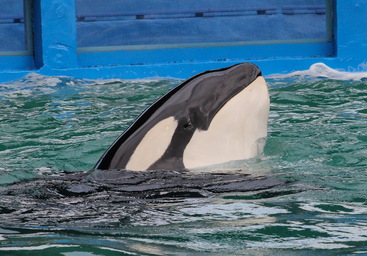Animal activists fought a long-standing battle for the release of Lolita, the once iconic attraction at the Miami Seaquarium, only to learn the orca died shortly after the aquatic park agreed to release her from captivity.
Lolita died Aug. 18, and activists say their fight is far from over. They plan to continue fighting for the release of other orcas in captivity and other sea mammals, such as bottlenose dolphins.
“The animals were taken from their pods and brought into the animal trade market,” said Thomas Copeland, an animal activist.

Originally known as Tokitae, Lolita was captured off the coast of Washington state, taken from her pod, and sold by trappers for about $20,000. She spent 58 years confined to a relatively small tank at the Seaquarium. Advocates sought her to be released to a whale sanctuary or slowly integrated back into her pod near Whidbey Island.
Naomi Rose, senior scientist in marine biology at Animal Welfare Institute, dedicated three decades to animal advocacy. Lolita, she said, “was the poster child for bad management of a captive animal.”
The Dolphin Company, which owns the Seaquarium, did not respond to phone calls and emails seeking comment.
Weighing 7,000 pounds and 21 feet in length, Lolita was confined to a tank with a maximum depth of 20 feet – and 12 feet at other points. Her immense size would dominate the tank if she could stand vertically. It was the smallest tank of its kind in the world, according to The Animal Legal Defense Fund.
For five-plus decades, Lolita was a key attraction at the Seaquarium, which opened in 1955 and was the second marine life attraction in Florida. At the start, part of its mission was educational.

It was one of several marine attractions across the United States, including SeaWorld in Orlando and San Diego, and Marineland in California and Florida. The Florida Marineland was the state’s first aquatic amusement park.
In recent years, due to documentaries like Blackfish and The Cove, there has been a surge of criticism against such attractions. The documentaries shed light on how orcas and bottlenose dolphins have been treated in captivity.
Copeland, an activist since 2017, has been at the forefront of the fight to release captive animals.
“Society has realized these conditions need to be boycotted,” he said.
Howard Garrett, co-founder and board president of the Orca Network, has been advocating for releasing orcas since the 1980s. He said that policy changes are in the works to mandate better treatment of marine life in captivity.
Lolita’s plight – and her death – focused attention on another captive orca who was taken off the coast of British Columbia and is currently at SeaWorld in San Diego. Corky, like Lolita, could face a struggle if reintegrated back into her original pod due to being cared for by humans for most of her life.
“In the future, I think companies like Miami Seaquarium and Seaworld are going more digitally so visitors of the parks could still be educated but also the animals are not under stressful conditions,” Garrett said.
As activists like Rose and Copeland continue their efforts to protect marine life, Lolita’s passing serves as a catalyst for positive change in the future of captive whales. Notably, petitions from Change.org and initiatives by World Animal Protection are advocating for the shutdown of facilities such as the Miami Seaquarium.
“I think in the next 20 years there will be no captive orcas or beluga whales,’’ Rose said. “I think Lolita and Corky would be the last generation of captive whales.”

































